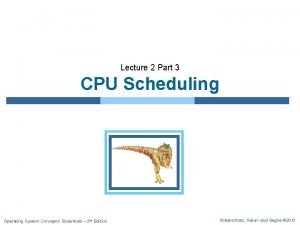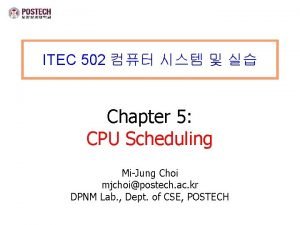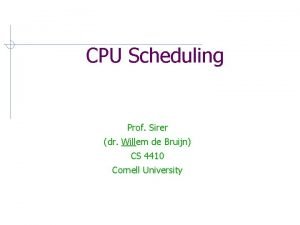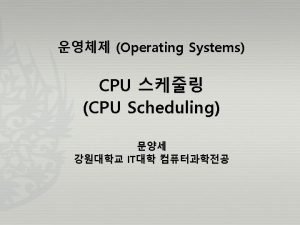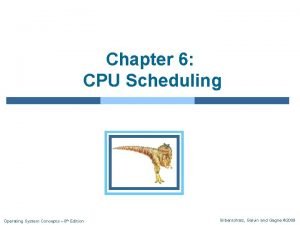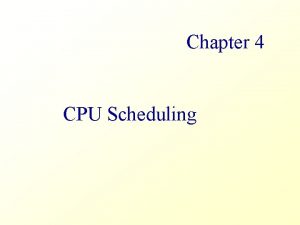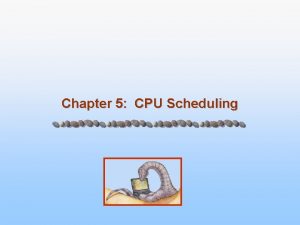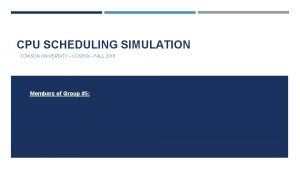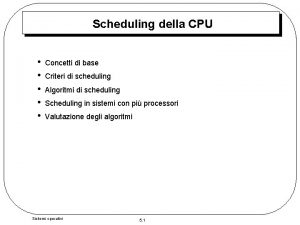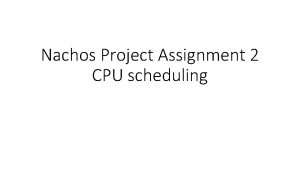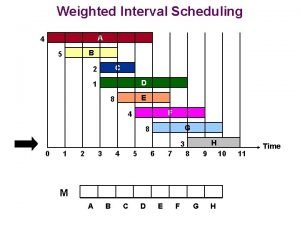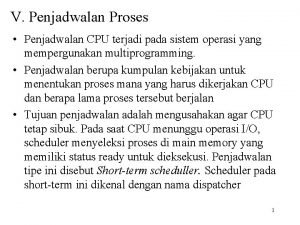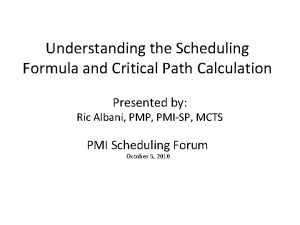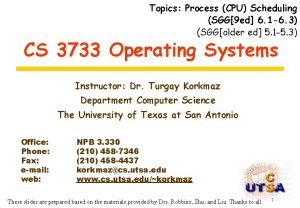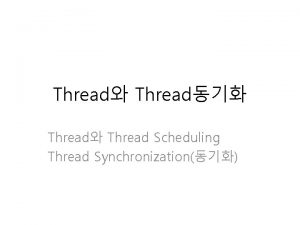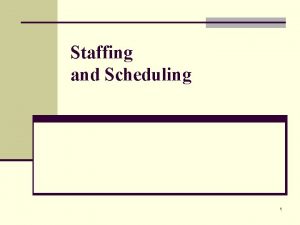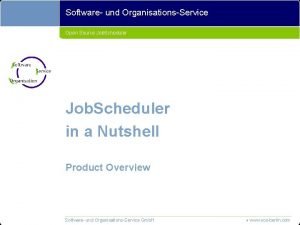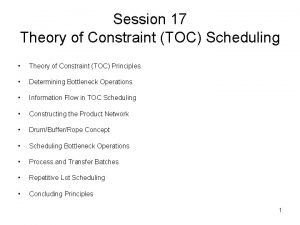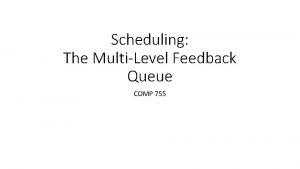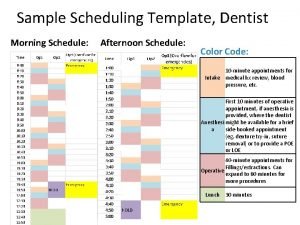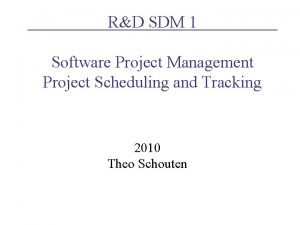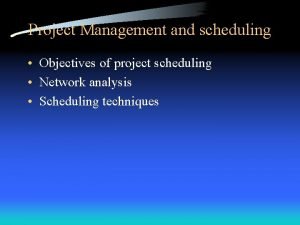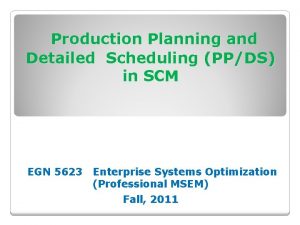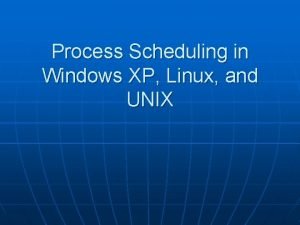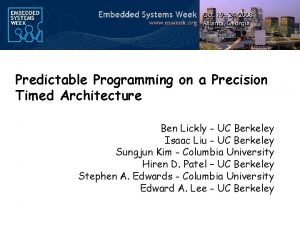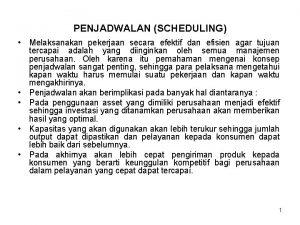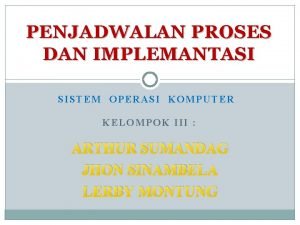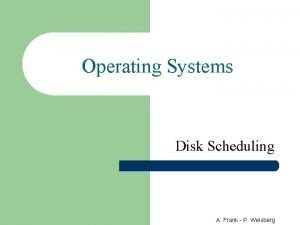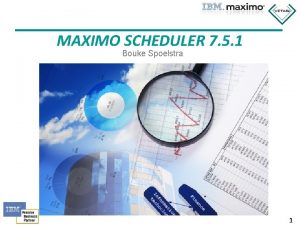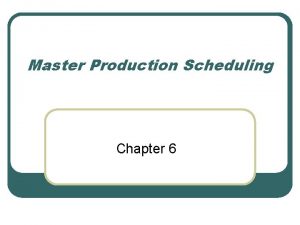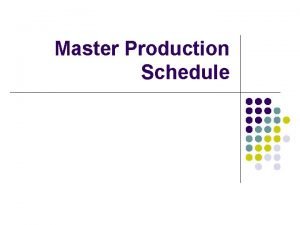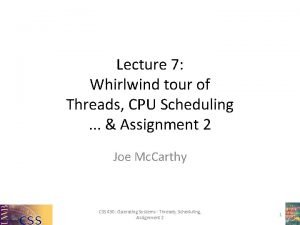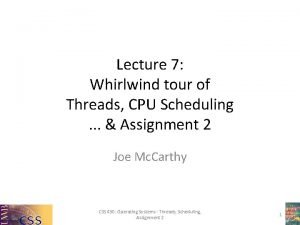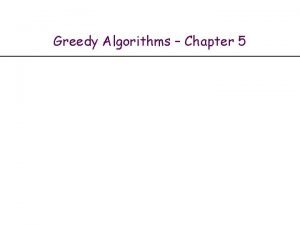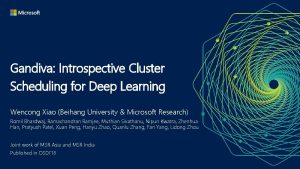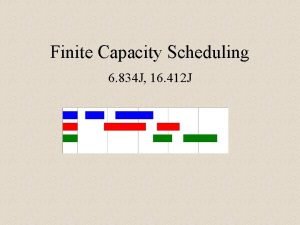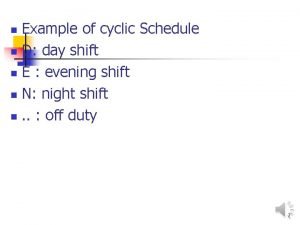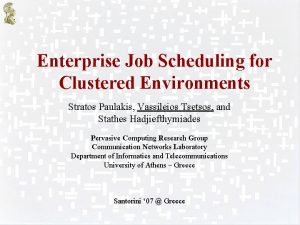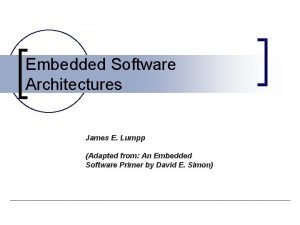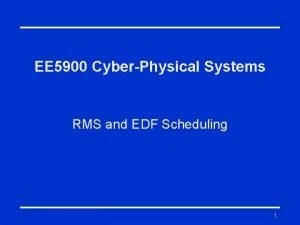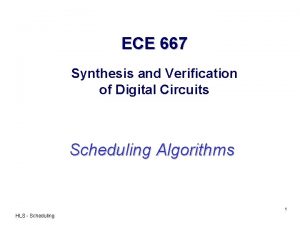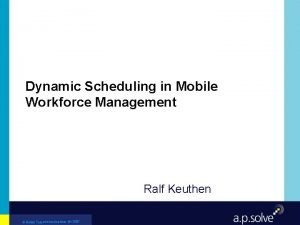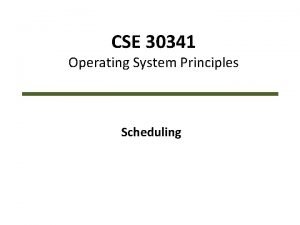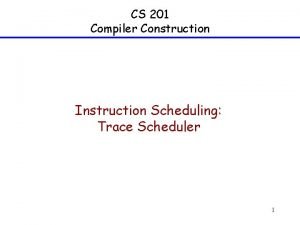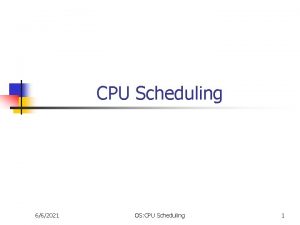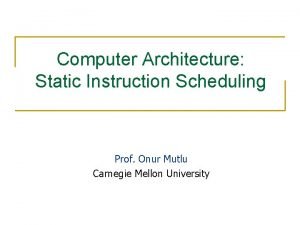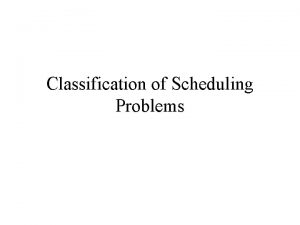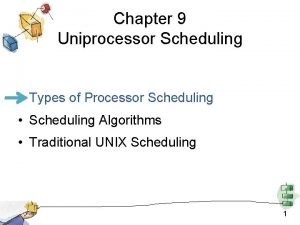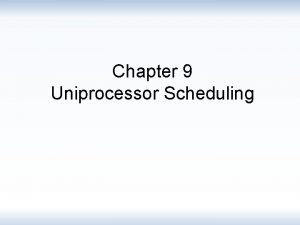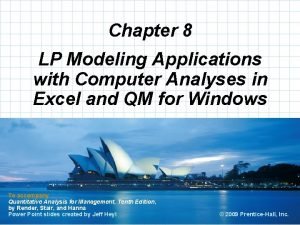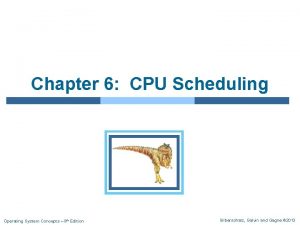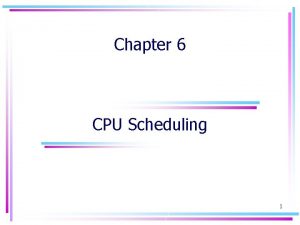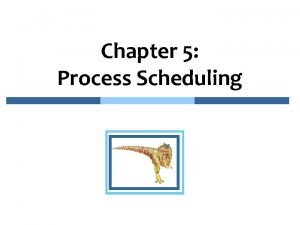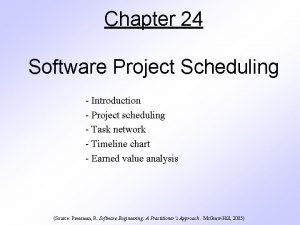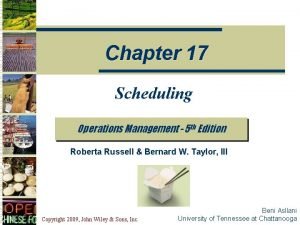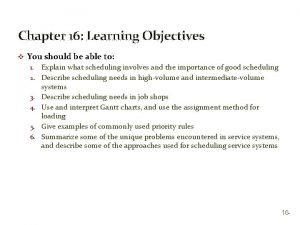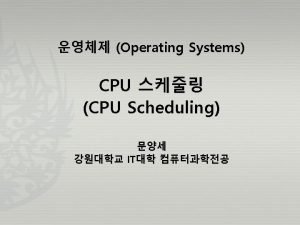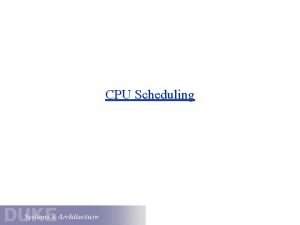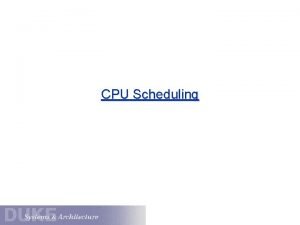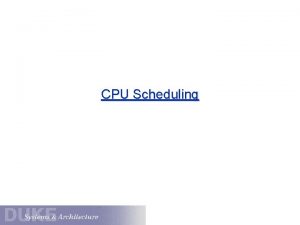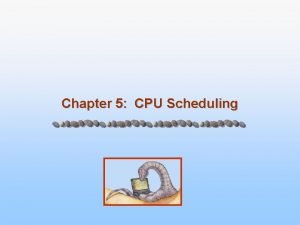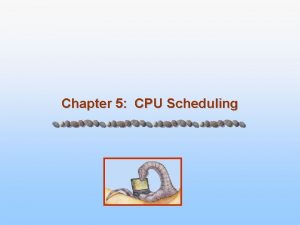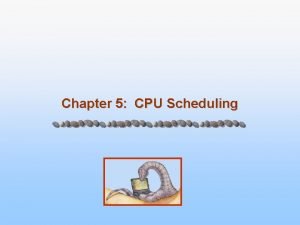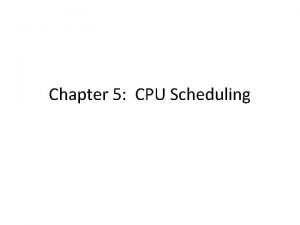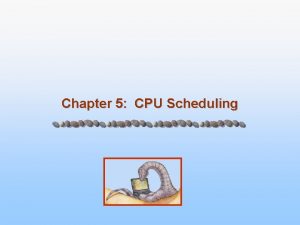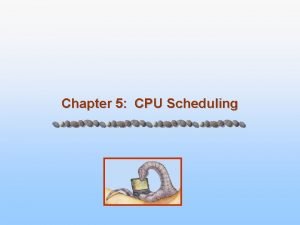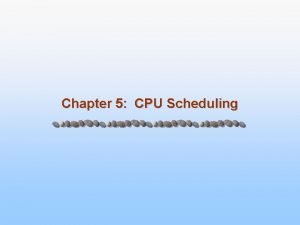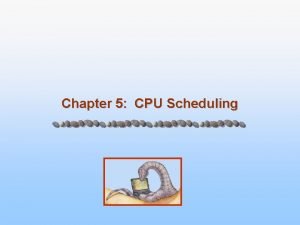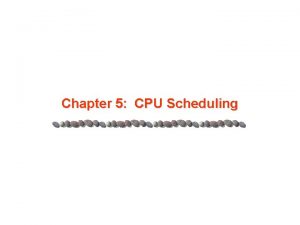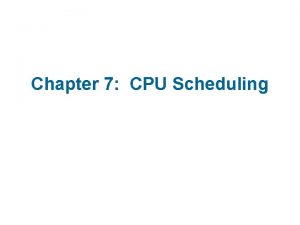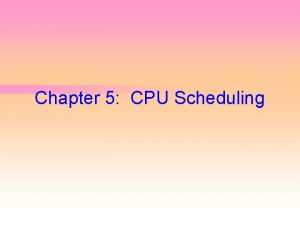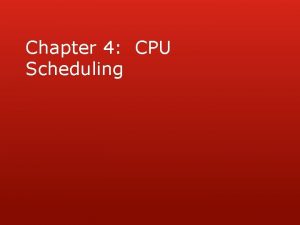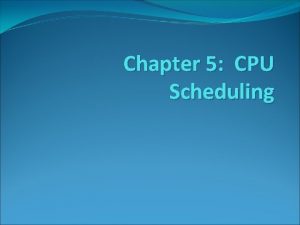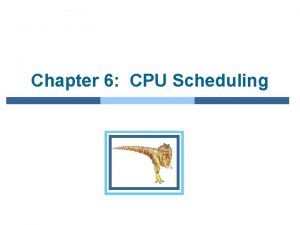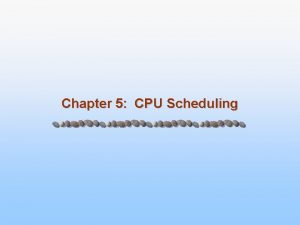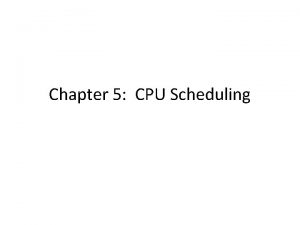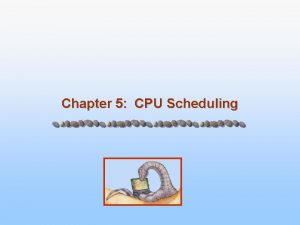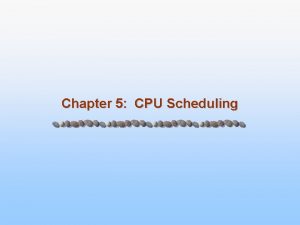Chapter 6 CPU Scheduling 1 Chapter 6 CPU












































































- Slides: 76

Chapter 6 CPU Scheduling 1

Chapter 6: CPU Scheduling • • • Basic Concepts Scheduling Criteria Scheduling Algorithms Multiple-Processor Scheduling Real-Time Scheduling Algorithm Evaluation 2

Basic Concepts § 6. 1 • The objective of multiprogramming is to maximum CPU utilization 爆裂 • CPU–I/O Burst Cycle – Process execution consists of a cycle of CPU execution and I/O wait. (Fig. 6. 1) • CPU burst distribution: a large number of short CPU bursts, and a small number of long CPU bursts. (Fig. 6. 2) 束縛,趨勢 • An I/O-bound program typically will have many short CPU bursts. A CPU-bound program might have a few long CPU bursts. continue 3

Alternating Sequence of CPU And I/O Bursts back 4

Histogram of CPU-burst Times back 5

CPU Scheduler § 6. 1. 2 • When CPU becomes idle, OS must selects from among the processes in memory that are ready to execute, and allocates the CPU to one of them. • CPU scheduling decisions may take place when a process: 1. Switches from running to waiting state. 2. Switches from running to ready state. 3. Switches from waiting to ready. 4. Terminates. 6

先佔 Preemptive Scheduling § 6. 1. 3 • Under nonpreemptive scheduling, once the CPU has been allocated to a process, the process keeps the CPU until it releases the CPU either by terminating or by switching to the waiting state. • Scheduling takes place only under 1 and 4 is nonpreemptive or cooperative, otherwise, it is preemptive. • Certain hardware platform can use cooperative scheduling only, because it does not equipped with the special hardware (ex: timer). 7

Preemptive Scheduling • Nonpreemptive: Windows 3. x, Mac. OS (previous version) • Preemptive: Windows 95, Mac. OS for Power. PC • Unfortunately, preemptive scheduling – incurs a cost associated with coordination of access to shared data. – Has an effect on the design of the OS kernel. 8

Dispatcher 分派 § 6. 1. 4 • Dispatcher module gives control of the CPU to the process selected by the short-term scheduler; this involves: – switching context – switching to user mode – jumping to the proper location in the user program to restart that program • Dispatch latency – time it takes for the dispatcher to stop one process and start running another…should be as fast as possible. 9

Scheduling Criteria § 6. 2 使用率 • CPU utilization – keep the CPU as busy as possible 產量 • Throughput – # of processes that complete their execution per time unit 回復 • Turnaround time – amount of time to execute a particular process • Waiting time – amount of time a process has been waiting in the ready queue • Response time – amount of time it takes from when a request was submitted until the first response is produced, not output (for time-sharing environment) 10

Optimization Criteria • • • Max CPU utilization Max throughput Min turnaround time Min waiting time Min response time 11

Scheduling Algorithms • 1. 2. 3. 4. 5. 6. § 6. 3 CPU scheduling deals with the problem of deciding which of the processes in the ready queue is to be allocated the CPU. First-Come, First-Served Scheduling Shortest-Job-First Scheduling Priority Scheduling Round-Robin Scheduling Multilevel Queue Scheduling Multilevel Feedback-Queue Scheduling 12

§ 6. 3. 1 First-Come, First-Served (FCFS) Scheduling 先到先做 Next in line to access the CPU Queue of PCBs for processes waiting to run New process enters system . . . . CPU Process in control of the CPU Process finishes 13

§ 6. 3. 1 First-Come, First-Served (FCFS) Scheduling • Example: Process Burst Time P 1 24 P 2 3 P 3 3 • Suppose that the processes arrive in the order: P 1 , P 2 , P 3 The Gantt Chart for the schedule is: P 1 0 P 2 24 P 3 27 30 • Waiting time for P 1 = 0; P 2 = 24; P 3 = 27 • Average waiting time: (0 + 24 + 27)/3 = 17 14

First-Come, First-Served (FCFS) Scheduling Suppose that the processes arrive in the order P 2 , P 3 , P 1. • The Gantt chart for the schedule is: P 2 0 P 3 3 P 1 6 30 • Waiting time for P 1 = 6; P 2 = 0; P 3 = 3 • Average waiting time: (6 + 0 + 3)/3 = 3 • Much better than previous case. 15

First-Come, First-Served (FCFS) Scheduling 護航 • Convoy effect: many short processes waiting for one long process to get off the CPU……lower CPU and device utilization. • FCFS scheduling algorithm is nonpreemptive. 16

最短先做 § 6. 3. 2 Shortest-Job-First (SJF) Scheduling • Associate with each process the length of its next CPU burst. Use these lengths to schedule the process with the shortest time. Not the total • Two schemes: length –job nonpreemptive – once CPU given to the process it cannot be preempted until completes its CPU burst. – Preemptive – if a new process arrives with CPU burst length less than remaining time of current executing process, preempt. This scheme is know as the Shortest-Remaining-Time-First (SRTF). 最短剩餘時間先做 • SJF is optimal – gives minimum average waiting time for a given set of processes. 17

Shortest-Job-First (SJF) Scheduling Process Burst Time P 1 6 P 2 8 P 3 7 P 4 3 P 4 0 3 P 1 P 3 9 P 2 16 24 • Average waiting time = (3 + 16 + 9 + 0)/4 = 7 • Compare to 10. 25 milliseconds of FCFS 18

SJF Difficulty • Knowing the length of the next CPU request is not easy. • SJF used frequently in Long-term scheduling with the user specifies the length when he submits the job. • SJF cannot be implemented at the level of short-term CPU scheduling…there is no way to know the length of the nest CPU burst. • We can only approximate SJF by predicting the next CPU burst to be similar in length to the previous ones. 19

Predicting the next CPU burst • Next CPU burst can be predicted as an exponential average of the lengths of previous CPU bursts. length of the nth CPU burst most recent information 0≦α≦ 1 relative weight predicted value for the nth CPU burst past history 20

Predicting the next CPU burst • =0 (Recent history does not count) – n+1 = n • =1 (Only the actual last CPU burst counts) – n+1 = t n • = ½ (recent history and past history are equally weighted) 21

Predicting the next CPU burst • If we expand the formula, we get: n+1 = t n+(1 - ) t n -1 + … +(1 - ) j t n -j + … +(1 - ) n+1 0 • Since both and (1 - ) are less than or equal to 1, each successive term has less weight than its predecessor. 22

Shortest-remaining-time-first scheduling • When a new process arrives at the ready queue while a previous process is executing, the new process may preempt the currently executing process. average time: • Process P 1 P 2 P 3 P 4 Arrival Time Burst Time 0 8 1 4 2 9 3 5 P 1 0 1 P 4 P 2 5 ((10 -1)+(17 -2)+(5 -3))/4 = 6. 5 milliseconds Nonpreemptive SJF: 7. 75 P 3 P 1 10 17 26 23

優先權 Priority Scheduling § 6. 3. 3 Measurable quantities: time Criteria external to OS: • A priority (integer) isimportance associatedofwith each limits, memorynumber requirements, the process, process. CPUfiles, is allocated with of the number of open ratio of to the typeprocess and amount funds highest priority average I/O burst to average of being paid, the department • SJF is. CPU a priority the is the burst scheduling where sponsoring work. predicted next CPU burst time. • Priorities can be defined either internally or externally. • Problem : Starvation –– low priority processes may never execute. 老化 • Solution : Aging – gradually increasing the priority of processes that wait in the system for a long time. 24

依序循環 Round Robin (RR) (環繞的知更鳥) § 6. 3. 4 • Designed for time-sharing systems with preemption added to the FCFS scheduling. 時間量 • Each process gets a small unit of CPU time (time quantum), usually 10 -100 milliseconds. After this time has elapsed, the process is preempted and added to the end of the ready queue. • The average waiting time under RR is often long: Process Burst Time P 1 P 2 P 3 P 1 24 P 2 3 0 4 7 10 P 3 3 P 1 14 P 1 18 P 1 22 P 1 26 30 The average waiting time is 17/3=5. 66 milliseconds 25

Round robin scheduling Process finishes Operating system removes control of the CPU from the currently executing process because of quantum expiration Next in line to access the CPU . . . . Circular queue of PCBs for processes in the ready state waiting to use the CPU Process in control of the CPU Process request an event for which it must wait Event is complete. PCB returns to queue so it can compete for CPU List of PCBs for processes waiting for the completion of an event, e. g. , an I/O operation

Round Robin (RR) • If there are n processes in the ready queue and the time quantum is q, then each process gets 1/n of the CPU time in chunks of at most q time units at once. No process waits more than (n -1)q time units. • Performance – q large FIFO – q small Called processor sharing, appears as n processes running at 1/n the speed of the real processor. (q must be large with respect to context switch, otherwise overhead is too high. ) 27

Small Time Quantum Increases Context Switches 28

Turnaround time v. s. time quantum • The average turnaround time of a set of processes does not necessarily improve as the time-quantum size increases. • In general, the average turnaround time can be improved if most processes finish their next CPU burst in a single time quantum. 29

Turnaround time v. s. time quantum 30

多層佇列 Multilevel Queue Scheduling § 6. 3. 5 • Ready queue is partitioned into separate queues: foreground (interactive) – Round. Robin background (batch) – FCFS • Each queue has its own scheduling algorithm • The processes are assigned to one queue based on some property of the process, such as memory size, process priority, or process type. • Scheduling must be done between the queues. – Fixed priority scheduling; i. e. , serve all from foreground then from background. Possibility of starvation. – Time slice – each queue gets a certain amount of CPU time which it can schedule amongst its processes; i. e. , 80% to foreground in RR, 20% to background in FCFS 31

Multilevel Queue Scheduling • There must be scheduling between the queues. Example: Fig. 6. 6 (Each queue has absolute priority over lower-priority queues. ) 1. Fixed-priority preemptive scheduling: – No process in the lower queue could run unless the higher queues were empty. – If higher level process entered the ready queue while a lower level process was running, the lower level process would be preempted. 2. Time slice between the queue: Each queue gets a certain portion of the CPU time. 32

Multilevel Queue Scheduling 33

多層回饋佇列 Multilevel Feedback Queue § 6. 3. 6 • A process can move between the various queues. • If a process uses too much CPU time, it will be moved to a lower-priority queue … leaves I/O bound and interactive processes in the higher-priority queues. • A process waits too long in a lower queue may be moved to a higher-priority queue. This aging prevents starvation. 34

Multilevel Feedback Queue • Example: Three queues: – Q 0 – time quantum 8 milliseconds – Q 1 – time quantum 16 milliseconds – Q 2 – FCFS • Scheduling – A new job enters queue Q 0 which is served FCFS. When it gains CPU, job receives 8 milliseconds. If it does not finish in 8 milliseconds, job is moved to queue Q 1. – At Q 1 job is again served FCFS and receives 16 additional milliseconds. If it still does not complete, it is preempted and moved to queue Q 2. 35

Multilevel Feedback Queue 36

Multilevel feedback queuing system WAIT state Generate Queue no. 1 I/O request Control of the CPU . . . . Process finishes Quantum expires WAIT state Queue no. 2. . . . Generate Control of the CPU . . . . Queue no. n. . . . I/O request . . Process finishes Quantum expires WAIT state Generate I/O request Control of the CPU Quantum expires Process finishes 37

Multilevel Feedback Queue • Multilevel-feedback-queue scheduler defined by the following parameters: – – – number of queues scheduling algorithms for each queue method used to determine when to upgrade a process method used to determine when to demote a process method used to determine which queue a process will enter when that process needs service • Although multilevel feedback queue is the most general scheme, it is also the most complex for the necessary of selecting values for all the parameters to define the best scheduler. 38

Multiple-Processor Scheduling § 6. 4 • CPU scheduling more complex when multiple CPUs are available. • We concentrate on systems in which the processors are identical – Homogeneous. • if several identical processors are available, then Load sharing can occur…provide a separate queue for each processor. • To prevent load unbalance, use a common ready queue. All processes go into one queue and are scheduled onto any available Two possible schemes processor. 39

Multiple-Processor Scheduling • Symmetric Multiprocessing (SMP) – each processor makes its own scheduling decisions. Each processor examines the common ready queue and selects a process to execute. • Asymmetric multiprocessing – having all scheduling decisions, I/O processing, and other system activities handled by one single processor – the master server. The other processors execute only user code. It is simpler because only one processor accesses the system data structures, alleviating the need for data sharing. 40

Real-Time Scheduling § 6. 5 • Hard real-time systems – required to complete a critical task within a guaranteed amount of time. – Need resource reservation. The scheduler know exactly how long it takes to perform each type of OS function. – Lack the full functionality of modern computers and OS. • Soft real-time computing – requires that critical processes receive priority over less fortunate ones. – Although may cause unfair allocation of resources and longer delays for some processes, it is at least 41 possible to achieve

Implementing soft real-time function 1. The system must have priority scheduling, and real-time processes must have the highest priority. 2. The dispatch latency must be small. not easy to ensure. The latency can be long since some system calls are complex and some I/O devices are slow. relatively simple to hold 42

Real-Time Scheduling • check to see whether a dispatch latency low, we need high-priority process If it does, a context system callsneeds to switch be to be run. takes place. To keep to allow preemptible. Ways to achieve this goal: 1. insert preemption points in longduration system calls. 2. make the entire kernel preemptible. To ensure correct operation, all kernel data structures must be protected through the use of various synchronization mechanisms. 43

Priority Inversion • Higher-priority process needs to wait when it needs to read or modify kernel data that are currently being accessed by another lower-priority process. • If there is a chain of lower-priority processes, they inherit the high priority until they are done with the resources. ––– priority-inheritance protocol 44

Dispatch Latency 45

Algorithm Evaluation § 6. 6 • When selecting a CPU scheduling algorithm for a particular system, different evaluation methods may be used: – Deterministic Modeling – Queueing Models – Simulations – Implementation 46

Deterministic Modeling § 6. 8. 1 • Analytic evaluation uses the given algorithm and the system workload to produce a formula or number that evaluates the performance of the algorithm for that workload. • One type of analytic evaluation is deterministic modeling. It takes a particular predetermined workload and defines the. Time performance each Consider theof. FCFS, Process Burst algorithm for Pthat workload. SJF, and RR (quantum 10 1 = 10 milliseconds). P 2 29 • Example: P 3 P 4 P 5 3 7 12 Which algorithm would give the minimum average waiting time? 47

Deterministic Modeling FCFS: Average waiting time is (0+10+39+42+49)/5=28 ms P 5 P 3 P 4 P 2 P 1 0 10 39 42 49 61 SJF: Average waiting time is (10+32+0+3+20)/5=13 ms P 3 P 4 P 1 P 5 P 2 0 3 10 20 32 61 RR: Average waiting time is (0+32+20+23+40)/5 = 23 ms P 1 P 2 P 3 P 4 P 5 P 2 0 10 20 23 30 40 50 52 61 48

Deterministic Modeling • Deterministic modeling is simple and fast. It gives exact numbers, allowing the algorithms to be compared. • However, it requires exact number for input, and its answers apply to only those cases. • The main uses are in describing scheduling algorithms and providing examples…too specific, and requires too much exact knowledge, to be useful • Used when the same program may be ran over and over again and can measure the program’s processing requirements exactly. 49

Queueing Models § 6. 8. 2 • Processes vary, no static set of processes to use for deterministic modeling. • What can be determined is the distribution of CPU and I/O bursts. • These distributions may be measured and then approximated. The result is a mathematical formula describing the probability of a particular CPU burst. • Arrival-time distribution given the distribution of times when processes arrive in the system. • From these two distribution, it is possible to compute the average throughput, utilization, waiting time, and so on for most algorithm. 50

Queueing Models the average arrival rate new is described as a network of The computer for system the • average in of waiting has a queueservers length eachprocesses…queueing-network the queue the analysis. average waiting time • Little’s Formula: n = λ× W in the queue during the time W that a process waits, λ× W new processes will arrive in the queue. • If the system is in a steady state, then the number of processes leaving the queue must be equal to the number of processes that arrive. • It is useful because it is valid for any scheduling algorithm and arrival distribution. 51

Queueing Models • Example: seven processes arrive every second (on average), normally 14 processes in the queue, the average waiting time per process is 2 seconds. • Limitations: – The classes of algorithms and distributions that can be handled are limited. – The mathematics of complicated algorithms or distributions can be difficult to work with. – Arrival and service distributions are often defined in unrealistic, but mathematically tractable, ways. 52

Simulations § 6. 8. 3 • Programming a model of the computer system with data structures represent the major components of the system. • The simulator modifies the system state to reflect the activities of the devices, the processes, and the scheduler. • As the simulation executes, statistics that indicate algorithm performance are gathered and printed. • More accurate evaluation than queueing models. 53

Simulations • The data to drive the simulation can be generated in several ways. – Random-number generator – • programmed to generate processes, CPU-burst times, arrivals, departures according to mathematically or empirically defined probability distributions. • may be inaccurate. It indicates only how many of each event occur; it does not indicate anything about the order of their occurrence. – Trace tapes • created by monitoring the real system, recording the sequence of actual events and use it to drive the simulation. • Excellent way to compare two algorithms on exactly the same set of real inputs. • Expensive and requires large storage space. 54 • Design, coding, and debugging involve major tasks.

Simulations 55

Implementation • The only completely accurate way to evaluate a scheduling algorithm is to code it up, to put it in the OS, and to see how it works. • Major difficulty: – high cost – the environment in which the algorithm is used will change. 56

Process Scheduling Models § 6. 7 • Process Local Scheduling – How the threads library decides which thread to run on an available LWP. (more software-library than OS concern) • System Global Scheduling – How the kernel decides which kernel thread to run next. (This text cover global scheduling only) 57

Solaris 2 Scheduling § 6. 7. 1 • Priority-based process scheduling • Four classes of scheduling: real time, system, time sharing, interactive. • Within each class there are different priorities and different scheduling algorithms. • Default scheduling class for a process is time sharing. 58

Solaris 2 Scheduling 59

Solaris 2 Scheduling 1. Time sharing: – dynamically alters priorities and assigns time slices of different lengths using a multilevel feedback queue. – Interactive processes typically have a higher priority; CPU-bound processes a lower priority. – gives good response time for interactive processes and good throughput for CPUbound processes 60

Solaris 2 Scheduling 2. Interactive class: – same scheduling policy as time-sharing but gives windowing applications a higher priority for better performance. 3. System class: – uses it to run kernel processes, such as the scheduler and paging daemon. 4. real-time class: – – gives the highest priority to run among all classes. Allows a real-time process to have a guaranteed response from the system within a bounded period of time. A real-time process will run before a process in any other class. 61

Windows 2000 § 6. 7. 2 • Windows 2000 schedules threads using a priority-based, preemptive scheduling algorithm. • A thread selected to run by the Dispatcher will run until it is preempted by – – a higher-priority thread terminates time quantum ends calls a blocking system call (e. g. I/O) 62

Windows 2000 Real-time thread • Preemption allow real-time threads to access the CPU. • However, Windows 2000 is not hardreal time OS, because it does not guarantee that a real-time thread will start to execute within any particular time limit. 63

The dispatcher • The Windows 2000 dispatcher uses a 32 -level scheme to determine the order of thread execution. • Priorities are divided into two classes: – the variable class contains threads having priorities from 1 to 15 – the real-time class contains threads with priorities ranging from 16 to 31 (priority 0 for memory management) 64

The dispatcher • A queue for each scheduling priority, traverses the set of queues from highest to lowest until it finds a thread that is ready to run. • If no thread is found, the dispatcher will execute a special thread called the idle thread. 65

Priorities • The numeric priorities of the Windows 2000 threads are identified by the Win 32 API. • Priority classes: – – – REALTIME_PRIORITY_CLASS HIGH_PRIORITY_CLASS ABOVE_NORMAL_PRIORITY_CLASS BELOW_NORMAL_PRIORITY_CLASS IDLE_PRIORITY_CLASS 66

Priorities • All priority classes except the REALTIME_ PRIORITY_CLASS are variable class priority. • Within each of these priority classes is a relative priority which has value: – – – – TIME_CRITICAL HIGHEST ABOVE_NORMAL BELOW_NORMAL LOWEST IDLE 67

Priorities • The priority of each thread is based upon the priority class it belongs to and the relative priority within the class real time high above normal time-critical 31 15 15 15 highest 26 15 12 10 above normal 25 14 11 9 normal 24 13 10 below normal 23 12 lowest 22 idle 16 below normal 15 base 8 priority idle priority 15 6 7 5 8 6 4 9 7 5 3 11 8 6 4 2 1 1 1 68

Priorities • Processes are typically members of the NORMAL_PRIORITY_CLASS. • The initial priority of a thread is typically the basic priority of the process the thread is belongs to. • When a thread’s time quantum runs out, that thread is interrupted and its priority is lowered. 69

Priorities • When a variable-priority thread is released from a wait operation, the dispatcher boosts the priority. • The amount of the boost depends on what the thread was waiting for. Ex: while permitting compute-bound threads – thread waiting for keyboard I/O would get Give good response times to interactive threads This strategy is used by several timea large priority increase that are using the mouse and in windows, and to use spare CPU cycles the sharing OS, including UNIX. – thread waiting for disk operation would get enables I/O-bound threads to keep the I/O device background. a moderate one. busy. 70

Foreground vs. Background • Windows 2000 distinguishes processes in the NORMAL_PRIORITY_CLASS between foreground process and background processes. • When a process moves into the foreground, Windows 2000 increases the scheduling quantum by some factor – typically 3 (a three times longer time to run). 71

Linux • Two separate process-scheduling algorithms: 1. for conventional, time-sharing processes, a prioritized, credit-based algorithm doing fair preemptive scheduling among multiple processes. 2. for real-time tasks taking priorities as more important factor than fairness. Part of every process’ identity is a scheduling class, that defines which of these algorithms to apply to the process. 72

Scheduling time-sharing processes • Each process possesses a certain number of scheduling credits. • When a new task must be chosen to run, the process with the most credits is selected. • Every time a timer interrupt occurs, the currently running process loses one credit; when its credits reaches zero, it is suspended another process is chosen. 73

Scheduling time-sharing processes Processes that are running all the time tend to • If no runnable processes have any exhaust their credits rapidly, but processes that credits, then Linux performs a spend much of their time suspended can recrediting operation, adding credits and to accumulate credits over multiple recreditings every process according consequently endinupthe withsystem, a higher credit count after a recredit. to the following rule: credits = (credits / 2) + priority retaining some history of the process’ recent behavior 74

Scheduling time-sharing processes • The crediting system automatically gives high priority to interactive or I/O bound processes, for which a rapid response time is important. • Background batch jobs get low priority automatically while receiving fewer credits than interactive jobs. 75

Scheduling real-time processes • Linux implements the two real-time scheduling classes required by POSIX. 1 b: FCFS and Round-robin. • Linux’s real-time scheduling is soft – rather than hard – real time. The scheduler offers strict guarantees about the relative priorities of real-time processes, but the kernel does not offer any guarantees about how quickly a real-time process will be scheduled. 76
 Sjn scheduling
Sjn scheduling Sjf cpu scheduling
Sjf cpu scheduling Multilevel queue scheduling
Multilevel queue scheduling Sjf cpu scheduling
Sjf cpu scheduling Fcfs gantt chart
Fcfs gantt chart Sjf cpu scheduling
Sjf cpu scheduling Sjf cpu scheduling
Sjf cpu scheduling Types of cpu scheduling
Types of cpu scheduling Preeptive
Preeptive Cpu scheduling project
Cpu scheduling project Scheduling della cpu
Scheduling della cpu Cpu scheduling project
Cpu scheduling project Weighted interval scheduling
Weighted interval scheduling Time sharing
Time sharing Critical path formula
Critical path formula Difference between preemptive and nonpreemptive scheduling
Difference between preemptive and nonpreemptive scheduling Thread scheduling
Thread scheduling Staffing and scheduling
Staffing and scheduling Open source enterprise scheduler
Open source enterprise scheduler Toc scheduling
Toc scheduling Scheduling elements casino
Scheduling elements casino 1/8 script breakdown
1/8 script breakdown Multilevel feedback queue scheduling code in java
Multilevel feedback queue scheduling code in java Scheduling resources and costs
Scheduling resources and costs Dental schedule templates
Dental schedule templates Forward scheduling in sap sd
Forward scheduling in sap sd Sdm in project management
Sdm in project management Forward pass scheduling
Forward pass scheduling Production planning and inventory control
Production planning and inventory control Ppds heuristics
Ppds heuristics Windows process scheduling algorithm
Windows process scheduling algorithm Thread scheduling
Thread scheduling Contoh penjadwalan scheduling
Contoh penjadwalan scheduling Process scheduling solver
Process scheduling solver Difference between preemptive and nonpreemptive scheduling
Difference between preemptive and nonpreemptive scheduling Disk scheduling policies
Disk scheduling policies Multilevel queue scheduling example with gantt chart
Multilevel queue scheduling example with gantt chart Priority queuing
Priority queuing Cyclic executive scheduling
Cyclic executive scheduling Maximo scheduler
Maximo scheduler Maximo asset management scheduler
Maximo asset management scheduler 12 principles of master production scheduling
12 principles of master production scheduling Master production schedule
Master production schedule Thread scheduling
Thread scheduling Thread scheduling
Thread scheduling Jerry banks simulation
Jerry banks simulation Scheduling in batch system
Scheduling in batch system Hncd
Hncd Interval scheduling algorithm - greedy approach
Interval scheduling algorithm - greedy approach Gandiva: introspective cluster scheduling for deep learning
Gandiva: introspective cluster scheduling for deep learning Forward and backward scheduling
Forward and backward scheduling What is finite loading
What is finite loading Finite capacity scheduling example
Finite capacity scheduling example Cyclical schedule example
Cyclical schedule example Enterprise job scheduling
Enterprise job scheduling Round robin with interrupts in embedded system
Round robin with interrupts in embedded system Parallel block scheduling for elementary schools
Parallel block scheduling for elementary schools Rms and edf scheduling example
Rms and edf scheduling example Asap and alap scheduling example
Asap and alap scheduling example Dynamic work scheduling
Dynamic work scheduling Thread scheduling
Thread scheduling Delay elements in disk read or write
Delay elements in disk read or write Os context switch
Os context switch Instruction scheduling in compiler design
Instruction scheduling in compiler design Priority scheduling
Priority scheduling Static scheduling in computer architecture
Static scheduling in computer architecture Classification of scheduling
Classification of scheduling Chi appointment scheduling
Chi appointment scheduling Uniprocessor scheduling
Uniprocessor scheduling Uniprocessor scheduling in os
Uniprocessor scheduling in os Employee scheduling excel solver
Employee scheduling excel solver Nsofbtty9p4 -site:youtube.com
Nsofbtty9p4 -site:youtube.com Shortest remaining time first scheduling
Shortest remaining time first scheduling Windows process scheduling
Windows process scheduling Basic principles of project scheduling
Basic principles of project scheduling Loading in operations management
Loading in operations management Scheduling in high-volume systems is known by what term?
Scheduling in high-volume systems is known by what term?

